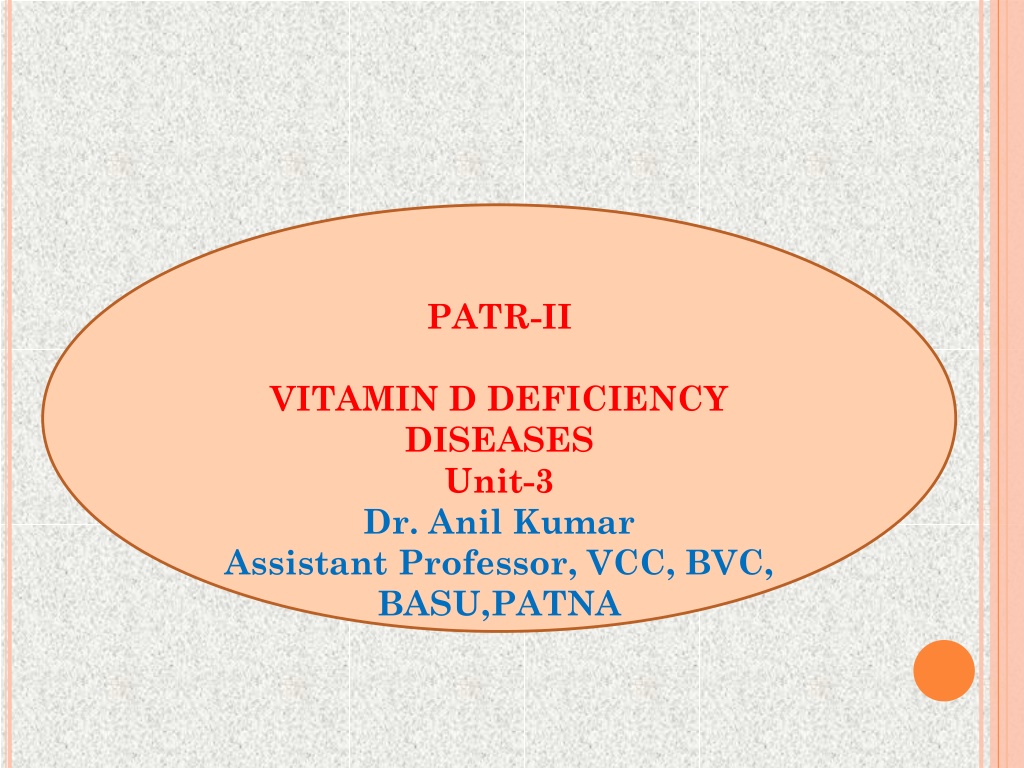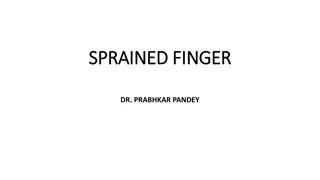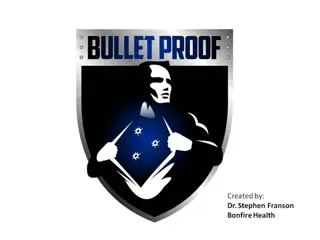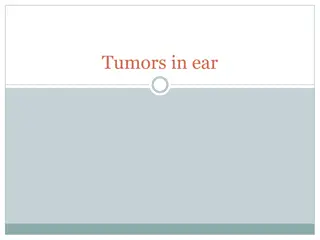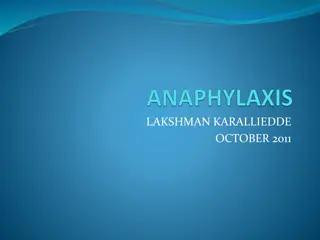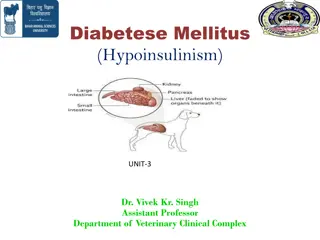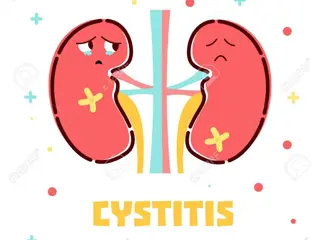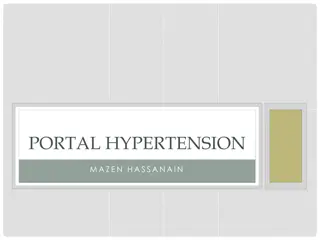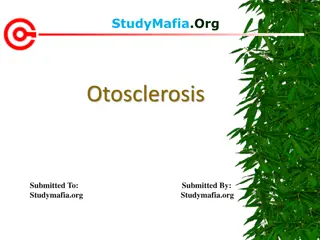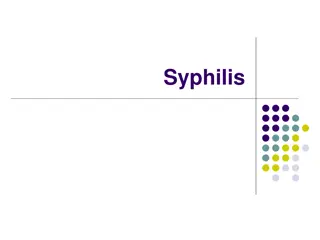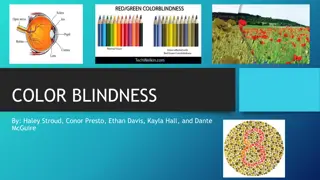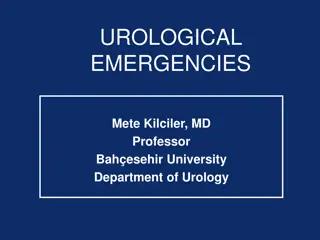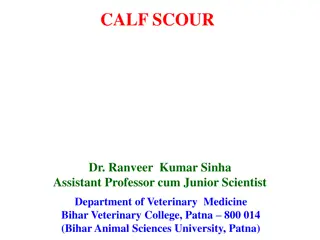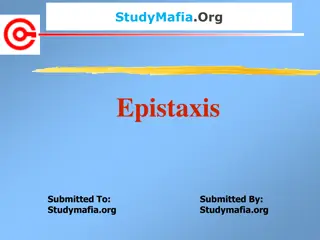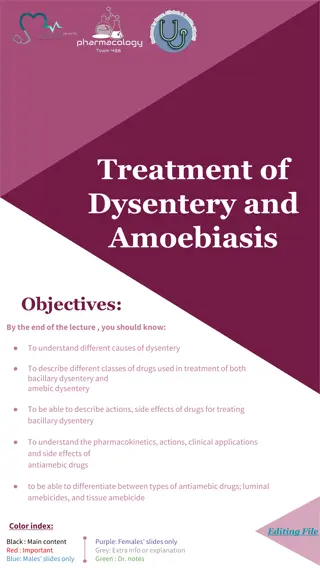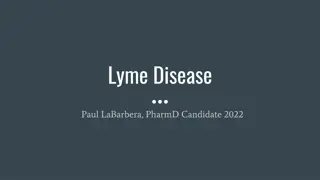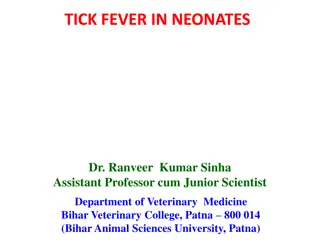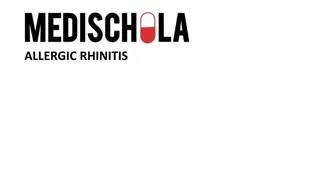Understanding Rickets: Causes, Symptoms, and Treatment
Rickets is a metabolic bone disorder primarily caused by vitamin D, calcium, or phosphorus deficiency. It leads to softening and weakening of bones, affecting young growing animals. Genetic defects, dietary deficiencies, and malabsorption are common causes. The pathophysiology involves decreased calcium absorption, hypocalcemia, stimulation of parathyroid hormone, and bone mobilization. Treatment typically includes supplementation of deficient nutrients and addressing underlying causes.
Download Presentation

Please find below an Image/Link to download the presentation.
The content on the website is provided AS IS for your information and personal use only. It may not be sold, licensed, or shared on other websites without obtaining consent from the author. Download presentation by click this link. If you encounter any issues during the download, it is possible that the publisher has removed the file from their server.
E N D
Presentation Transcript
PATR-II VITAMIN D DEFICIENCY DISEASES Unit-3 Dr. Anil Kumar Assistant Professor, VCC, BVC, BASU,PATNA
RICKETS RICKETS Rickets is a disease of young growing animals caused by impaired mineralization of physeal and epiphyseal cartilage during endochondral ossification and of newly formed osteoid Rickets is a metabolic bone disorder caused either due to deficiency of : Vitamin D Calcium or phosphorus in diet or Due to malabsorption of these elements from intestine AND ultimately leading to softening and weakening of the bones The most common causes of rickets and osteomalacia in animals are dietary deficiencies of vitamin D or phosphorus. Note: Osteoid- is the unmineralized, organic portion of the bone matrix that forms prior to the maturation of bone tissue.
Genetic defects (sheep, pigs and domestic cats including Human) The overall homeostasis of calcium and phosphorus are regulated by: PTH, the vitamin D endocrine system and FGF23 (phosphatonin fibroblast growth factor 23). In Calves phosphorus and Vitamin D deficiencys the most common form of rickets in cattle raised indoors for prolonged periods Horses are less dependent on vitamin D for intestinal absorption of calcium, which rickets/osteomalacia being relatively rare in equids, although fibrous osteodystrophy is comparatively common Vitamins D2 and D3 are biologically inactive and must undergo two hydroxylation reactions to be activated: The Vit. D3 25-hydroxylation occur in Liver by cytochrome P450, then after transportation to Kidney second 1alpha-hydroxylation takes place in PCT in kidney 1,25-dihydroxyvitamin D3, the active form of vitamin D may contribute to
PTH also has a 2 major role: Stimulation of bone breakdown by osteoclasts Potent inducer of renal synthesis of 1,25(OH)2D3, an active form of Vit. D and helps in stimulates active intestinal absorption of calcium In the cat and dog, the dermal concentrations of 7- dehydrocholesterol (7-DHC) are too low to produce vitamin D through UVB exposure and they are more dependent on their carnivorous diet, which contains good sources of: vitamin D (blood, fat) phosphorus (meat) and calcium (bones).
PATHO-PHYSIOLOGY OF RICKETS Deficiency of Vit. D/ Deficiency of Calcium in Diet Decreased absorption of Calcium from Gut Hypocalcaemia/Hypocalciuria Stimulation of PTH Mobilization of Ca from bone, Decrease phosphorous re- sorption from Kidney leading to Phosphateuria and Hypophosphatemia Negative in Calcium and Phosphorous Balance Disturbance in Bone metabolism and Mineralization leading to weak and thin bones RICKETS
Clinical rickets is characterized by the following: Stiffness in the gait Enlargement of the limb joints, especially in the forelegs Enlargement of the costochondral junctions Long bones showing abnormal curvature, usually forward and outward at the carpus, in sheep and cattle Lameness and a tendency to lie down for long period
The lesions of rickets are found in multiple bones especially ofmetaphyseal and epiphyseal regions of the long bones and the costochondral junctions. In animals with rickets, the growth plate thickened, the cortex is thinned and the bones mineralized Histologically features characterize rickets: expansion of the hypertrophic chondrocytes in the growth plate and accumulation unmineralized (osteoid) is irregularly are poorly two major of bone matrix
POULTRY: Rickets in modern birds usually occurs between 2 and 4 weeks of age. Occurs due to disturbances in calcium, vitamin D or phosphorus metabolism secondary to dietary deficiencies Poultry are also susceptible to tibial dyschondroplasia, and clinically characterized by lameness and leg deformities. Clinically, there is : Poor growth, Weakness, Lameness Inability to stand and Prominent valgus or varus deformations of the femur and/or tibiotarsus.
Cattle : Mostly associated with phosphorus deficiency ( stiff sickness ). Cattle are considered more susceptible than sheep to phosphorus deficiency Clinical signs included: Osteophagia Stiff or lame gait Swollen joints and Spontaneous fractures
Horse:--- Rickets is rare in horses. Horses have higher serum calcium concentrations. The normal levels of plasma vitamin D metabolites in the horse are lower than those inducing rickets in other species. Pig:--- When dietary vitamin D is inadequate. Barn designs that restrict exposure to sunlight have also been a factor in outbreaks. Affected piglets may have muscle tremors, are lame and reluctant to move, preferring a dog sitting or in a hunched back posture, and can die suddenly from hypocalcemia; they have costochondral junctions and growth plates, and both acute and chronic fractures can be present. soft bones, enlarged
Dogs and Cats:-- oFailure of both vascular invasion and mineralization in the area of provisional calcification of the physis. Bone pain, stiff gait, swelling in the area of the metaphyses, difficulty in rising, bowed limbs, and pathologic fractures. On radiographic examination, the width of the physes is increased, the non-mineralized physeal area is distorted, and the bone may show decreased radiopacity. Lameness is the initial functional disturbance in growing dogs and may vary from a slight limp to inability to walk. The bones are painful on palpation, and folding fractures of long bones and vertebrae are common
Diagnosis:-- History Diet deficient in Ca, P, and Vitamin D, winter season, type of grass/feed etc. may helpful for the diagnosis of rickets. Clinical signs like stiffness of gait and enlargement of the distal physis of long bones mainly observed on metacarpus and metatarsal as a circumscribed painful swollen joints and bendings of bones are also helpful. Biochemical estimation phosphatase. Radiographic examination: Lack of density compared to normal Widening of epiphyseal (Pathognomonic) The epiphyseal ends of long bones have a woolly, moath eaten appearance, and have a concave or flat appearance instead of normal contour. like Ca, P and alkaline plate and epiphyseal line
Treatment: Animals should provide rich calcium and Phosphorous diet like Fishmeal, meat meal and bone meal. Adequate feeding of Ca, P and Vit. D preprations like dicalcium phosphate, shark-liver oil, calcium lactate(orally/IV), cod-liver oil or cotton seed (rich in P) is necessary. Lamb: Vit. A and Vit. D and calcium borogluconate solution containing magnesium and phosphorous parenterally and supplementation of diet with bone meal and protein. Vit. D therapy for rickets should be given 10-20 times of its daily requirement(700 IU for dogs; 1500IU for sheep, cattle, pig and horse dail). In pups: Providing organic meat such as liver, Kidney or heart. Massage of long bones with oil containing Vit. A and D and putting them in sun light. A good diet containing 1-1.2% calcium and 0.8-1% phosphorous, exercise and fresh air should be provided Dogs of rachitic diathesis should not be used for breeding.
Vitamin D poisonings in animals can result from: ingestion of plants excess dietary supplementation ingestion of cholecalciferal(vitamin D3) In vitamin D toxicity, intestinal calcium absorption is increased, as is mobilization of calcium from the bone, while excretion from the kidney is reduced The result is hypercalcemia and hyperphosphatemia, which, if chronic, results in soft tissue mineralization AND Death from renal failure rodenticides containing
OSTEOMALACIA Osteomalacia is a disease of mature animals affecting bones in which endochondral ossification has been completed and is characterized by lesion is osteoporosis and the formation of excessive uncalcified matrix (osteoid). Lameness and pathologic fractures are the common clinical findings ETIOLOGY: Same as for Rickets except that the predisposing cause is not the increased requirement of growth but the drain of lactation, pregnancy, or both. Its main occurrence is in cattle in areas seriously deficient in phosphorus. In feedlot animals (indoors), excessive phosphorus intake without complementary calcium and vitamin D may lead condition
Pathogenesis: Increased resorption of bone mineral to supply the needs of pregnancy, lactation, and endogenous metabolism leads to osteoporosis and weakness and deformity of the bones Large amounts of uncalcified osteoid deposited around the diaphyses There is role of fibroblast growth factor 23 CLINICAL FINDINGS Ruminants: Licking and chewing of inanimate objects begins at early stage painful condition of the bones and joints with a stiff gait; lameness and often shifting from leg to leg Crackling sounds while walking; and an arched back. Hocks may be rotated inward
Disinclined to move, lie down for long periods, and are unwilling to get up The colloquial names cripples, and bog lame for such syndrome. Pigs: Recumbent and unable to rise from lateral recumbency or from the dog-sitting position The shaft of one femur or the neck of the femur is commonly fractured Diagnosis: Increased serum alkaline phosphatase and decreased serum phosphorus levels. Radiographic examination decreased density of bone shadow. pegle, creeps, stiffs, of long bones shows
OSTEODYSTROPHIA FIBROSA It occurs in horses, goats, and pigs due to laid down of soft, cellular, fibrous tissue instead of the specialized uncalcified osteoid tissue of osteomalacia Secondary nutritional hyperparathyroidism---in Equines Renal hyperparathyroidism-----in Dogs ETIOLOGY: A secondary calcium deficiency resulting from excessive phosphorus feeding in Horse and pigs Tropical grasses contain oxalate, which interferes with mineral utilization by horses by forming calcium oxalate, which renders the calcium unavailable for intestinal absorption The disease can be readily produced in horses on diets with a ratio of calcium : phosphorus of 1 : 2.9 or greater, irrespective of the total calcium intake
TREATMENT AND CONTROL: A balanced ration with regard to calcium and phosphorus (calcium : phosphorus should be in the vicinity of 1 : 1 and not wider than 1 : 1.4) is preventive in horses The affected animals can only be treated by correcting the existing imbalance. Cereal hay may be supplemented with alfalfa or clover hay, or finely ground limestone (30 g daily) should be fed. Dicalcium phosphate and bone meal are not as efficient because of their additional content of phosphorus.
